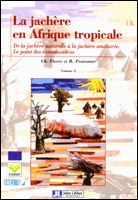(for every order > 35€)
Proceedings of the International Seminary, Dakar, Avril 1999
Written in French – Summaries in English
In tropical Africa, the traditional system of land use consists of a cropping period (5 to 15 years) followed by abandonment of the land (fallow) as soon as there is a drop in yeld and soil fertility or and extensive attack of weeds or parasites. The fallow period (10 to 30 years depending on the climate) which followed the cropping allowed for the return of soil fertility due to the installation of the typical trees and shrubs of the savanah zone. This period of natural fallow is a source of wood, supplies, produces small fruits, plants for medicinal purposes and serves as grazing area.
This system worked very well until quite recently. Due to the important increase of population, the tendancy to settle and the droughts, a large increase has taken place in the surface area of crops and decline of that fallow.
Two projects on fallow have been initiated with the ambition to restaure and develop fallows areas. This international seminar was held at Dakar in April 1999 gathering researchers and developers coming from a largne numbur of countries to discuss about the better ways to promote these actions.
The following themes were included
- Fallow and agricultural systems
- Fallow and fertility
- Fallow and soil biology
- Vegetation of fallows and post-cultivation succession
- Products from natural fallow (wood, etc)
- Forage production in natural and improved fallow
- Cropping systems with short-term fallows
- Tree improved fallow
- Restoration of degraded fallows
